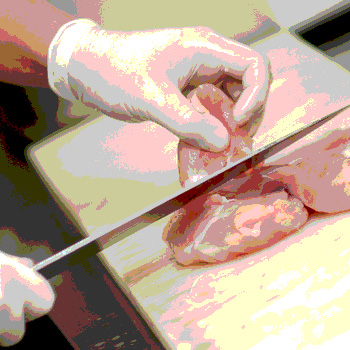On October 20, 2014, the U.S. Department of Agriculture (USDA) Food Safety and Inspection Service (FSIS) implemented its new Modernization of Poultry New Slaughter Inspection Regulation. Touted in the press as the “privatization’ of poultry inspection, critics raise concerns that leaving more of the inspection responsibility to the facilities themselves will reduce the effectiveness and objectivity of the inspections. At the same time, the process of transitioning to this new poultry inspection system has raised questions about whether the transition has caused a decrease in the effectiveness of the entire USDA system.
The New Poultry Inspection System (NPIS) has two primary component parts:
1. NPIS is designed for facilities that slaughter young chickens and any that slaughter turkeys. Those facilities may elect to follow new requirements which intend to better control Salmonella and Campylobacter. NPIS will not replace the current Streamlined Inspection System (SIS), the New Line Speed Inspection System (NELS) or the New Turkey Inspection System (NTIS). Thus, young chicken and turkey slaughter establishments may choose to operate under NPIS or may continue to operate under their current inspection system. USDA is not limiting the number of online inspectors in traditional inspections but will continue to staff all establishments that do not choose to operate under NPIS with their current number of online inspectors.
2. In addition to NPIS for young chickens and turkeys, this final rule includes changes to the regulations that will apply to all establishments that slaughter poultry other than ratites. Under this final rule, all poultry slaughter establishments must develop, implement and maintain written procedures to ensure pathogen controls and testing requirements, and they must incorporate these procedures into their Hazard Analysis and Critical Control Points (HACCP) plans or Sanitation Standard Operating Procedures (SSOPs) or other prerequisite programs.
The new NPIS system actually reduces the number of USDA inspectors to two per line. While reducing the number of Agency personnel, NPIS is designed to facilitate pathogen reduction in poultry products by relying upon FSIS inspectors to perform more offline inspection activities at critical points where the Agency feels are more effective in ensuring food safety where adulteration is most likely identified.
The key elements of the new NPIS rule are as follows:
• Requiring that personnel of the particular slaughter facility, rather than USDA inspectors, sort carcasses and remove unacceptable carcasses and parts before the birds are presented to the FSIS carcass inspector (CI)
• Shifting Agency resources to conduct more offline inspection activities that are more effective in ensuring food safety, which will result in having one offline verification inspector (VI) per line per shift
• Replacing the Finished Product Standards (FPS), which apply to establishments that continue operating under SIS, NELS and NTIS, with a requirement that establishments that operate under NPIS maintain records to document that the products resulting from their slaughter operations meet the definition of ready-to-cook (RTC) poultry
• Authorizing young chicken slaughter establishments to operate at a maximum line speed of 140 birds per minute, provided that they maintain process control
Under NPIS, there will be one online CI and one offline VI assigned to each evisceration line. CIs will conduct a continuous online inspection of each carcass at a fixed location immediately before the chiller to ensure that each carcass is not adulterated. CIs under NPIS will be able to conduct a more efficient and effective online carcass inspection than online inspectors do under the current inspection systems because the CIs will be presented with carcasses that have been sorted, washed and trimmed by establishment employees, which makes identification of adulteration easier to spot.
VIs under NPIS will conduct offline food safety-related inspection activities and will monitor and evaluate establishment process controls. VIs will conduct carcass verification checks on carcass samples collected before the CI station to ensure that the establishment is effectively sorting carcasses and that it is producing products that comply with the Agency’s zero visible fecal tolerance and other performance standards.
VIs and CIs will work with the inspector-in-charge to ensure that the carcasses presented to the CI are not affected with food safety defects or other conditions at levels that may impair the CI’s ability to effectively inspect each carcass. VIs will also perform offline activities in addition to carcass verification checks, such as verifying compliance with SSOPs, sanitation performance standards, and HACCP regulatory requirements, and ensuring that the establishment is meeting all regulatory requirements and is effectively preventing contamination by enteric pathogens and fecal material throughout the entire slaughter and dressing process.
Transitional Issues
The net result of NPIS will be to reduce the USDA presence in the targeted poultry facilities by as many as 630 poultry inspectors nationwide. In anticipation of the implementation of the new system, USDA has implemented hiring freezes on inspectors across the board so that they are prepared to integrate the displaced poultry inspectors into other poultry or red meat plants.
During this interim period, critics claim there is a severe shortage of USDA inspectors nationwide. Some inspectors are traveling from plant to plant, working as much as 80 hours per week. USDA has also made do by hiring some temporary inspectors until the poultry inspectors need to be integrated. But temporary jobs pay little and offer less training. Some say that some meats in supermarkets stamped as “USDA Inspected” may have never been inspected at all.
The final version of NPIS was published in the Federal Register on August 21, 2014. Because NPIS is optional, even for facilities which slaughter young chickens and turkeys, these facilities have 6 months from that August date to advise USDA whether they choose to participate. At that time, USDA will create a staggered implementation plan for transitioning facilities onto the new system. How long it will take to complete that transition will depend upon the number of facilities that elect NPIS. Thus, it may be many months, if not years, before this transition and the shifting of USDA inspectors to other facilities is completed. In the meantime, those other facilities continue to operate with a shortage of inspectors.
Conclusion
NPIS is a dramatic revision to the inspection of poultry. While it is criticized as being biased, privatization of the inspection process, USDA believes that it will allow its inspectors to more accurately and quickly identify adulteration. But as with any major governmental procedure, change happens slowly. And change often carries with it unintended consequences which cause less than desired results in the interim. But with the expectation that NPIS will prevent more than 5,000 Salmonella and Compylobacter foodborne illnesses per year, the potential benefits may be well worth the effort.
Kathy Hardee, Esq., and Joanne Woltman, Esq., are members of the Food & Agriculture Industry Group at Polsinelli, PC, which is comprised of attorneys from every legal practice area who each have a focused background in the food industry.
>




